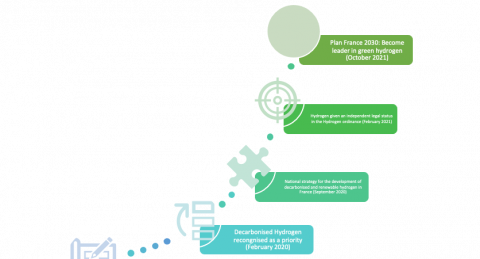France
Green hydrogen vision
France identifies decarbonized hydrogen as a priority investment area to achieve its nationally determined contributions (NDCs) towards the Paris Agreement. The government aims to achieve carbon neutrality by 2050 and become a leader in green technology to produce hydrogen domestically. As part of its national strategy on renewable hydrogen, France aims to decarbonize mobility and industries by establishing two giga factories of electrolyzers and use hydrogen to reduce industry emissions with 35% by 2030. (Plan France 2030).
“By 2030, France must be able to count on its soil at least two giga-factories of electrolyzers in order to massively produce hydrogen and all the technologies needed for its deployment” - Emmanuel Macron, President of France
National Strategy
France is one of the first countries to deploy a national hydrogen program as early as 2018. In September 2020, a National strategy for the development of decarbonied and renewable hydrogen in France was presented by the Ministry of the Ecological Transition.
The strategy lists out three key priority areas for the development of decarbonised hydrogen solutions:
-
Decarbonising industry by developing a French electrolysis sector
-
Developing the use of decarbonised hydrogen for heavy-duty mobility
-
Supporting research, innovation, and skills development to promote the uses of tomorrow.
Further to this, in October 2021, the French President Emmanuel Macron, announced Plan France 2030. It is an investment plan to address great challenges in France, in particular the ecological transition. Out of the 10 objectives listed in the plan, the second one is to become a decarbonised hydrogen leader. The plan aims at establishing two giga factories on the French soil by 2030 and use hydrogen to reduce industry emissions with 35% by 2030.
In accordance with the 2019 Energy and Climate Law, the Ordinance n°2021-167 dated 17 February 2021 (the Hydrogen Ordinance) granted hydrogen an independent legal status. This detailed legal framework aims to promote the French hydrogen sector development, by referring to three different types of hydrogen distinct from European definitions (renewable hydrogen, low carbon hydrogen and fossil hydrogen)1. To be qualified as renewable hydrogen, hydrogen must be produced (1) either by electrolysis using electricity produced by renewable energy sources or by any other technology using exclusively one or more renewable energy sources, and (2) whose production process does not exceed a greenhouse gas emission threshold.

Capacity and price
-
The Plan France 2030 set a decarbonised hydrogen production target of 700,000 tonnes of renewable or low carbon hydrogen per annum by 2030.
-
The electrolyser capacity target is 6.5 GW by 2030.
-
According to the measures in Plan France 2030, the price target is set at $1.6 per kg by 2030 .
Impact targets
-
Curb 6 Metric tonnes CO2 by 2030 (reduce emissions by 35% by 2030).
-
To promote carbon-free H2-fueled heavy mobility.
-
200 fuel cell buses in France by 2023, 800-2000 by 2028.
-
To develop a fully integrated and competitive sector with 50,000 to 150,000 jobs
Policy and Project Spotlight
“We must develop our industrial offer in hydrogen and invest massively in this sector. All this will allow us to decarbonize our industry, to fuel our trucks, our buses, our trains, our planes” - Emmanuel Macron, President of France
-
Injection of hydrogen in natural gas networks2: The government intends to use existing gas networks to transport hydrogen. The transport network and natural gas distribution managers will oversee the injection of hydrogen in the national gas network.
-
Implementation of a hydrogen tracing system: Guarantee of origin is necessary, particularly if hydrogen is likely to be merged with another type of hydrogen or another gas, to ensure that the source of hydrogen is known to the consumers.
-
Financing to scale up hydrogen projects: The Hydrogen Ordinance provides that renewable and low-carbon hydrogen producers are eligible for a support scheme providing financing for capital and operating expenditures. Moreover, the Multiannual Energy Program (Programmation pluriannuelle de l’énergie -PPE), set up for the periods 2019–2023 and 2024– 2028, provides additional financial support for the French hydrogen sector. Finally, in addition to the support mechanism and local calls for projects, decarbonized hydrogen projects will be funded through the PIA (Investment for the future program) and the IPCEI (Important Project of Common European Interest).
Financing
-
The public support extended by the government for the development of decarbonised hydrogen sets a trajectory until 2030 with a total of €7bn, with €2bn to be directly invested as part of the government recovery plan to address the economic impact of the Covid-19 pandemic.
-
Subsidy per gigawatt of electrolyser capacity committed: €1.08billion3.
-
€500 million in disruptive technologies, in renewable energies, in particular wind, land, offshore and photovoltaics, towards the second objective of Plan France 2030.
Government green hydrogen lead
-
National Hydrogen Council
-
France 2030 and General Secretariat for Investment (SGPI)
